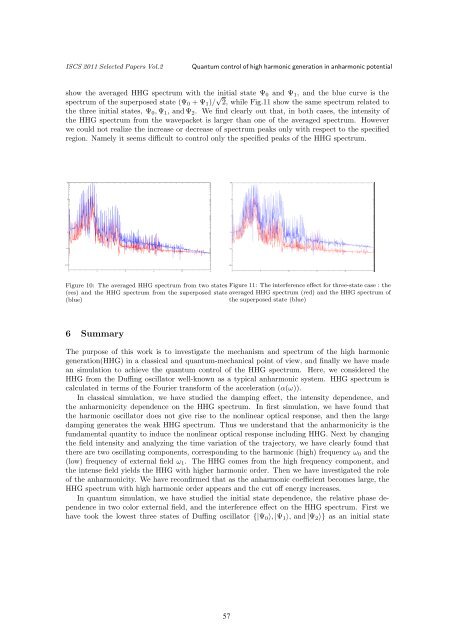RECENT DEVELOPMENT IN COMPUTATIONAL SCIENCE
RECENT DEVELOPMENT IN COMPUTATIONAL SCIENCE
RECENT DEVELOPMENT IN COMPUTATIONAL SCIENCE
Create successful ePaper yourself
Turn your PDF publications into a flip-book with our unique Google optimized e-Paper software.
ISCS 2011 Selected Papers Vol.2 Quantum control of high harmonic generation in anharmonic potential<br />
show the averaged HHG spectrum with the initial state Ψ0 and Ψ1, and the blue curve is the<br />
spectrum of the superposed state (Ψ0 + Ψ1)/ √ 2, while Fig.11 show the same spectrum related to<br />
the three initial states, Ψ0, Ψ1, and Ψ2. We find clearly out that, in both cases, the intensity of<br />
the HHG spectrum from the wavepacket is larger than one of the averaged spectrum. However<br />
we could not realize the increase or decrease of spectrum peaks only with respect to the specified<br />
region. Namely it seems difficult to control only the specified peaks of the HHG spectrum.<br />
Figure 10: The averaged HHG spectrum from two states Figure 11: The interference effect for three-state case : the<br />
(res) and the HHG spectrum from the superposed state averaged HHG spectrum (red) and the HHG spectrum of<br />
(blue)<br />
the superposed state (blue)<br />
6 Summary<br />
The purpose of this work is to investigate the mechanism and spectrum of the high harmonic<br />
generation(HHG) in a classical and quantum-mechanical point of view, and finally we have made<br />
an simulation to achieve the quantum control of the HHG spectrum. Here, we considered the<br />
HHG from the Duffing oscillator well-known as a typical anharmonic system. HHG spectrum is<br />
calculated in terms of the Fourier transform of the acceleration (α(ω)).<br />
In classical simulation, we have studied the damping effect, the intensity dependence, and<br />
the anharmonicity dependence on the HHG spectrum. In first simulation, we have found that<br />
the harmonic oscillator does not give rise to the nonlinear optical response, and then the large<br />
damping generates the weak HHG spectrum. Thus we understand that the anharmonicity is the<br />
fundamental quantity to induce the nonlinear optical response including HHG. Next by changing<br />
the field intensity and analyzing the time variation of the trajectory, we have clearly found that<br />
there are two oscillating components, corresponding to the harmonic (high) frequency ω0 and the<br />
(low) frequency of external field ω1. The HHG comes from the high frequency component, and<br />
the intense field yields the HHG with higher harmonic order. Then we have investigated the role<br />
of the anharmonicity. We have reconfirmed that as the anharmonic coefficient becomes large, the<br />
HHG spectrum with high harmonic order appears and the cut off energy increases.<br />
In quantum simulation, we have studied the initial state dependence, the relative phase dependence<br />
in two color external field, and the interference effect on the HHG spectrum. First we<br />
have took the lowest three states of Duffing oscillator {|Ψ0〉, |Ψ1〉, and |Ψ2〉} as an initial state<br />
57


